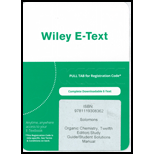
Interpretation:
The masses and relative intensities of the peaks in the molecule on region for given compound is to be determined.
Concept Introduction:
Few elements such as
Chemical shift is the measurement on
NMR resonance generally splits into
The proportion of each isotope is determined by its
Want to see the full answer?
Check out a sample textbook solution
Chapter 9 Solutions
ORGANIC CHEMISTRY-ETEXT REG ACCESS
- ANALYSE, PLOT AND GIVE THE CORRESPONDING FUNCTIONAL GROUP OF THE FOLLOWING PEAKarrow_forwardusing the following NMR spectrum please indentify their chemical shifts and their multiplicityarrow_forwardBased upon the following NMR SPectrum please list the chemical shifts, multiplicity, and assignments of the major peaksarrow_forward
- I need help calculating the NMR chemical shifts for this compound.arrow_forwardHow many peaks in NMR will be given by the Hydrogen b of the upper image and how many by the Hydrogen b of the lower image and how do I find it?arrow_forwardWhat peak pattern would you expect for the molecular ion of 1,1-dibromoethane?arrow_forward
- Predict the chemical shift of the following compounds? find out different types of protons and give their approximate chemical shift values based on their shielding and de shielding.arrow_forwardIndicate the peaks of this spectrum using the tablearrow_forwardCompare the literature IR spectrum to the experimental IR spectrum in a few sentences to show that the two spectra have the same peaks at the same wavenumbers with the same shapes.arrow_forward
- I need a table made online for a 1H-NMR and 13C-NMR based on the spectrum linked The labeled diagram has to include 1H: chemical shift , multiplet structure, integration, signals 13C: chemical shift , multiplet structure, integration, signalsarrow_forwardHow can you recognize molecular ion peak.arrow_forwardWhy is this the correct spectra for these molecules? Identify specific absorption band which identifies each characteristic functional group of the molecule chosen.arrow_forward
 Organic Chemistry: A Guided InquiryChemistryISBN:9780618974122Author:Andrei StraumanisPublisher:Cengage Learning
Organic Chemistry: A Guided InquiryChemistryISBN:9780618974122Author:Andrei StraumanisPublisher:Cengage Learning
